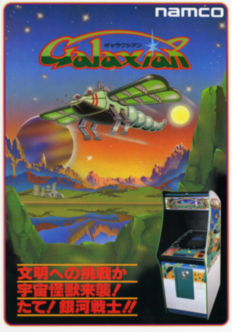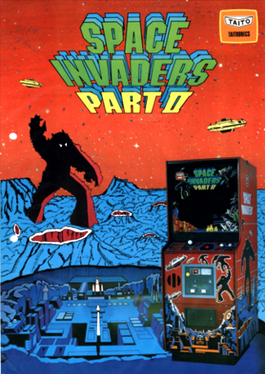
The Bally Astrocade is a second-generation home video game console and simple computer system designed by a team at Midway, at that time the videogame division of Bally. It was originally announced as the "Bally Home Library Computer" in October 1977 and initially made available for mail order in December 1977. But due to production delays, the units were first released to stores in April 1978 and its branding changed to "Bally Professional Arcade". It was marketed only for a limited time before Bally decided to exit the market. The rights were later picked up by a third-party company, who re-released it and sold it until around 1984. The Astrocade is particularly notable for its very powerful graphics capabilities for the time of release, and for the difficulty in accessing those capabilities.

Tapper, also known as Root Beer Tapper, is an arcade video game developed by Marvin Glass and Associates and released in 1984 by Bally Midway. Tapper puts the player in the shoes of a bartender who must serve eager, thirsty patrons while collecting empty mugs and tips. It was distributed in Japan by Sega in 1984.

Galaxian is a 1979 fixed shooter arcade video game developed and published by Namco. The player assumes control of the Galaxip starfighter in its mission to protect Earth from waves of aliens. Gameplay involves destroying each formation of aliens, who dive down towards the player in an attempt to hit them.

Tron is a coin-operated arcade video game manufactured and distributed by Bally Midway in 1982. The game consists of four subgames inspired by the events of the Walt Disney Productions motion picture Tron released earlier in the summer. The lead programmer was Bill Adams. The music programmer was Earl Vickers.

Tomohiro Nishikado is a Japanese video game developer and engineer. He is the creator of the arcade shoot 'em up game Space Invaders, released to the public in 1978 by the Taito Corporation of Japan, often credited as the first shoot 'em up and for beginning the golden age of arcade video games. Prior to Space Invaders, he also designed other earlier Taito arcade games, including the shooting electro-mechanical games Sky Fighter (1971) and Sky Fighter II, the sports video game TV Basketball in 1974, the vertical scrolling racing video game Speed Race in 1974, the multi-directional shooter Western Gun in 1975, and the first-person combat flight simulator Interceptor (1975).

Gun Fight, known as Western Gun in Japan and Europe, is a 1975 multidirectional shooter arcade video game designed by Tomohiro Nishikado, and released by Taito in Japan and Europe and by Midway in North America. Based around two Old West cowboys armed with revolvers and squaring off in a duel, it was the first video game to depict human-to-human combat. The Midway version was also the first video game to use a microprocessor instead of TTL. The game's concept was adapted from Sega's 1969 arcade electro-mechanical game Gun Fight.
The following article is a broad timeline of arcade video games.

Arch Rivals is a basketball video game released by Midway for arcades in 1989. Billed by Midway as "A Basket Brawl", the game features two-on-two full court basketball games in which players are encouraged to punch opposing players and steal the ball from them. Arch Rivals was the second basketball video game released by Midway, sixteen years after TV Basketball (1974). Home versions of the game were released for the Nintendo Entertainment System, Genesis/Mega Drive, and Game Gear.

Wizard of Wor is an arcade video game released in 1981 by Midway. Up to two players fight together in a series of monster-infested mazes, clearing each maze by shooting the creatures. The game was ported to the Atari 8-bit computers, Commodore 64, Atari 2600, and Atari 5200 and renamed to The Incredible Wizard for the Bally Astrocade. The original cartridge came with a cash prize offer to the first person to complete the game.

Journey is an arcade video game released by Bally Midway in 1983. Rock band Journey had enjoyed major success in the early 1980s, and Bally/Midway decided to ride this wave of popularity by creating an arcade game based on the group. Its release was intended to coincide with a US tour by the band.

Space Invaders Part II is a 1979 fixed shooter arcade video game developed and published by Taito. In North America, it was distributed by Midway Games as Space Invaders Deluxe. It is the sequel to Space Invaders (1978). The player controls a laser base that must destroy formations of descending aliens, while avoiding their projectiles. New features have been added, such as aliens that split into two when shot, an increased high score limit with the player able to save their name as initials, and short cutscenes in-between stages. It runs on the Taito 8080 arcade system.
Blasted is a shoot 'em up arcade video game released by Bally Midway in 1988.

Wacko is a 1983 arcade game by Bally Midway. It featured a unique angled cabinet design and a combination of trackball and joystick controls.

Timber is an arcade game manufactured by Bally Midway in 1984. The goal is to amass points by chopping down trees, then logrolling in bonus rounds. Two players can compete simultaneously in the same play area. Timber was designed by Steve Meyer, who also designed Tapper, and both games have a similar audio/visual style.
Pleiades (プレアデス) is a fixed shooter arcade game released in 1981 by Tehkan and licensed to Centuri. The name is shown on the title screen as Pleiads. The title comes from the mythical Greek Pleiades, the seven daughters of the titan Atlas.
Sente Technologies was an arcade game company. Founded as Videa in 1982 by several ex-Atari employees, the company was bought by Nolan Bushnell and made a division of his Pizza Time Theatre company in 1983. In 1984 the division was acquired by Bally Midway who continued to operate it until closing it down in 1988. The name Sente, like Atari, is another reference to Bushnell's favorite game, Go and means "having the initiative."

Speed Race is a 1974 arcade racing video game developed and manufactured by Taito and released under the titles Racer and Wheels in North America by distributor Midway Manufacturing in 1975. Designed by Tomohiro Nishikado, the gameplay involves the player using the attached steering wheel to maneuver a car alongside a fast vertical scrolling road. The objective is to score points by driving past other cars without colliding with them; more points are awarded for driving faster. Players must do this under a 90-second time limit, which ends the game when it runs out. The gameplay concepts were adapted from two earlier driving electro-mechanical games: Kasco's Mini Drive (1958) and Taito's Super Road 7 (1970).

Space Zap is a space-themed fixed shooter arcade video game developed by Game-A-Tron and licensed to Midway Manufacturing in 1980. The player controls the defenses of an immobile base in the center of the screen which is attacked from the top, bottom, left, and right. Pressing one of four oversized buttons moves the gun in the corresponding direction. A fifth button fires. Space Zap shipped in three form factors: standard upright, cocktail, and Bally's Mini-Myte reduced size cabinet.
Brian Colin is an American video-game designer, artist and animator. Among his best-known works are the coin-operated arcade games Rampage, Arch Rivals and Rampage: World Tour as well as General Chaos for the Sega Genesis game console. He is the CEO of Game Refuge, an independent video-game design and development studio with offices in Downers Grove, Illinois. He has been noted for his work in the field of bitmapped video-game graphics and animation, creating video-game sprites and tiled background graphics with a recognizable, identifiable style.
Two Tigers is a multidirectional shooter created by Bally Midway and released as an arcade video game in 1984. One or two players each control a World War II-era fighter plane to shoot enemy planes which fall and damage a naval ship at the bottom of the screen. After enough damage, the ship explodes. Players can also drop one bomb at a time to the same effect. An alternate dogfight mode allows two players to attempt to down each other's plane.














